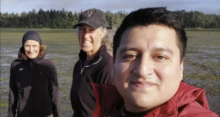In a collaborative research project funded by the Washington Sea Grant, Jennifer Ruesink, UW Biology Professor, and Kerry Naish, UW Aquatic and Fishery Sciences Professor, seek to protect and restore the eelgrass meadows in Washington State. Their research was featured in an article in WSG's summer issue of Seastar.
Eelgrass is a true plant that roots itself in the soft sediment bottoms off the coast. It flowers and produces seeds like any terrestrial plant. Like kelp, though, eelgrass forms dense communities that support a wide array of other organisms like young salmon, crabs, herring, mollusks, shrimp and others. And like the West Coast’s well-known bull kelp (Nereocystis luetkeana), eelgrass is facing population declines, habitat loss and recovery challenges.
Habitat disturbance from development, agricultural practices and industrial use in coastal areas and upland watersheds disrupts the clean and clear waters in which eelgrass grows best. Direct disturbances from vessel anchors and propellers or overwater structures like private docks tend to destroy beds or block the sunlight that eelgrass needs to grow. These threats and resulting declines have prompted the Washington Department of Fish and Wildlife to list eelgrass as a species of special concern. Further, eelgrass’s unique importance to the coastal ecosystem has led to the species’ listing as critical habitat by Washington Department of Ecology’s Shoreline Management Act. Conservation and restoration of this species has become an important part of the state’s plans, so much so that Washington recently passed legislation creating a Sea Star statewide kelp and eelgrass health and conservation plan. The plan aims to conserve and restore at least 10,000 acres of kelp and eelgrass in the state. But how do we protect and get these eelgrass meadows to grow? A research project funded by WSG is trying to find out.
The WSG study is headed by Kerry Naish and Jennifer Ruesink, respectively University of Washington professors in Aquatic and Fishery Sciences and Biology, as well as doctoral student Bryan Briones Ortiz. Their research first looked at the baseline genetic structure of the eelgrass population in Washington state. You can find eelgrass meadows from south Puget Sound up into the San Juan Islands and in the bays along the outer coast. The questions the researchers asked were: are these meadows all very closely related or nothing alike? Is each population very diverse or fairly homogenous? Will eelgrass from one bay adapt to grow in other locations?
“To make good decisions about which donor populations to use, and which investments to make in restoration, it helps to know the population genetic structure” says Ruesink. “[It] allows managers to make better decisions about conservation and restoration.”
Surprisingly, it turns out that the eelgrass populations in the state are genetically distinct from each other. This means that, genetically, eelgrass found in Grays Harbor and Willapa Bay is different from eelgrass in Puget Sound. Even among the populations in the Sound, the meadows in south Sound are distinct from the ones in Hood Canal and in north Sound. The distinctiveness of eelgrass populations in Washington indicates that managers will have to be selective when choosing sources for meadow rebuilding projects.

